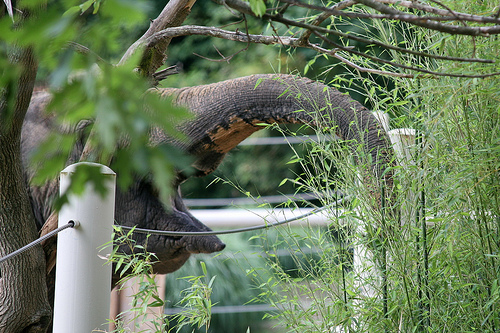CONSERVATION ACTION: Wild elephants are usually not a tiger’s prey. But the calves are still threatened by the wild cat and to keep a herd safe, the jumbos need to stay alert. Now researchers believe they can utilise the keen predator sensing skills of elephants to avoid crop raiding and other elephant-human conflict.
A study conducted a few years ago found African elephants to have a very keen sense of hearing which they can use to distinguish between the roar of a male or a female African lion in the savannahs. Male lions are more likely to attack the jumbos therefore the elephant’s cautious observation of the roar is required for the safety of her family.
Taking cue from the same observation, Vivek Thuppil, an animal behaviorist at the University of California–Davis and his fellow researchers studied Asian elephants to find if they could also tell the calls of the wild predators apart and differentiate between the ones that are a bigger threat and those that are not.
A Crawl and a Stomp
Thuppil had heard of a farmer in south India who was using a recording of a tiger’s roar to keep elephant’s away from his farm.
The researcher thought of testing the clever idea and therefore using video cameras camouflaged with elephant dung, they documented Asian elephants’ reactions to pre-recorded tiger and leopard growls along village farm roads in southern India. This experiment was done at night when the crop raiding by wild elephants occurred frequently.
The results and the difference in reactions of the elephant herd to the leopard and tiger growls were surprising.
When the pachyderms heard a tiger’s growl, they silently crept away from the fields, not wanting to come in the way of the regal predator.
When on the other hand they heard the leopard’s growl, they still retreated but it included stomping, circling, and trumpet calls.
“You don’t want to get involved with anything that has claws and teeth,” says Thuppil. “So, they eventually decided to choose the safe option, which was interesting.”
The tigers could harm the elephant calves, and the elephants therefore chose to retreat silently from the fields. Leopards on the other hand, were not a big threat therefore although they left, they did so making as much noise as possible to maybe scare the leopard as well.
“It would pay for the elephants to recognize when a tiger is nearby so they can retreat, without wasting time by running away for every big-cat growl they hear,” says Lucy Bates another researcher not affiliated with the study.
Thuppil says that among elephants too, each individual has a distinct sound it makes and the members of a herd do recognise these individual voices. He says it is the unique guttural pulse patterns in each animal’s growl that helps the elephants distinguish between their fellow family members and also between the growls of the feline species.
Stopping Man-Elephant Conflict
In India annually about 200 human lives are lost due to man-elephant conflict. Sadly, it is the same number of elephants that die annually because of the similar tensions arising mostly because of retaliatory killing by farmers when elephants venture out of forests in search of food.
With rising number of elephant corridors vanishing as a result of agriculture and forest degradation, the strain between the animal-human relations is increasing. At such times, it is necessary that measures are taken that ensure minimum harm and fatalities at both ends.
“This study adds to our growing knowledge of how elephants perceive the world, and it is exciting because it could have implications for the struggle to reduce human-elephant conflict,” says Bates.
Broadcasting tiger growls over speakers could be an easy way to trick elephants into steering clear of Indian villages. But that conservation strategy might stop working if elephants get used to hearing the sounds.
“Something like this would need to be more fine-tuned,” says Thuppil.
The researchers now plan to see if the sound of the tiger growl can be played from different positions to make the elephants think of it as a moving prey and thus retreat from fields.
It is definitely an idea worth considering without bringing harm to either humans or the elephants.
More Related Stories,
Life threatening Railway Tracks
Warning: Wild Elephants Spotted Near your Home
Scientists Develop Model to Predict Human-Elephant Conflict Zones
Image via cc/Flickr by cliff








What a brilliant idea. Anything that can help these endangered creatures is to be welcomed and when it’s combined with such ingenuity- brilliant.
Absolutely Zoe. That such a simple idea can work in favor of the animals as well as reduce man-animal conflicts is a great advantage. Hopefully, the idea can be adopted soon and reduce clashes between farmers and elephants. Thank you for your comment. Keep visiting.